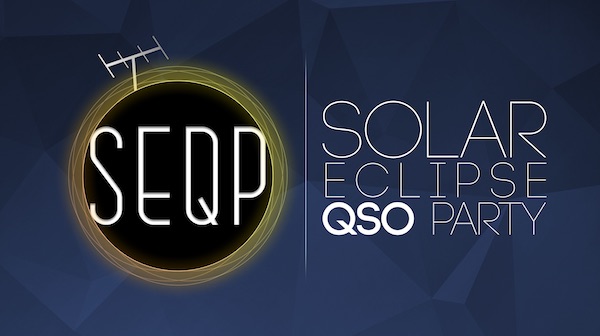SEQP 2023 and 2024 FAQs

The following is an informal introduction to the SEQP. Please visit the full SEQP Rules for detailed explanations of all terms, links to useful sites, and just about everything needed to prepare for and operate in the SEQP. The rules also contain details on after-contest scoring and log submission. These FAQs are a brief, informal recap of the actual SEQP rules. In case of any conflicts or questions, the SEQP rules should be considered the definitive resource. The SEQP is but one event within the Festivals of Eclipse Ionospheric Science.
What is a Solar Eclipse QSO Party, and why is it being held?
The Solar Eclipse QSO Party is an opportunity for amateur radio operators (hams) to operate during the October, 2023 and April, 2024 eclipses, before, during and after they pass over North America. Using various modes (CW, voice, and digital), two-way transmissions (QSOs) made during the SEQP will contribute to scientific studies focusing on the ionosphere’s reaction to the eclipse. The studies should lead to a better understanding of the interactions between the Sun, the ionosphere, and radio wave propagation. That research should benefit hams, professional broadcasters, satellite operators and many other users of radio spectrum.
Results from the 2023 SEQP are available here
Results from the 2024 SEQP are available here
When will the SEQP occur? (Download and open the ICS files below to add the events to your electronic calendar)
- October 14, 2023; 1200-2200 UTC; is the official 2023 SEQP event period.
- April 8, 2024; 1400-2400 UTC; is the official 2024 SEQP event period.
- The SEQPs both starts a few hours before the eclipses begins their transit across the US mainland, so baseline data can be gathered (it is important to know how well the ionosphere is reflecting and refracting high frequency (HF) signals prior to the eclipses)
- They continue through the entire eclipse period, in order to study how HF propagation is affected by the eclipse (past experience suggests that ionospheric changes will be visible in the data).
- They conclude a few hours after the eclipses transit beyond the US mainland, in order to observe and study the after effects of the eclipse (such as ionospheric recovery, if any).
You do not have to operate the full SEQP hour period, though that would be most welcome. If you only have an hour or two, try to schedule your operating when the eclipse path is nearest to your QTH. That will raise the odds that your signals will be affected by the eclipse. Eclipse paths can be seen at https://www.greatamericaneclipse.com/.
Who should participate?
The 2023 and 2024 eclipses will be passing over the continental United States, so researchers are most interested in having hams in North America participate. Of course, HF radio signals don’t generally restrict themselves to small geographic areas, so hams from all over the world are welcome to operate and enter the SEQP.
What equipment is required?
Almost any ham station can participate. An HF radio and antenna(s), usable on one or more of the 160, 80, 40, 20, 15 10 and 6 meter bands.
It is extremely helpful to have contest logging software on a computer in your station. The software guides you through the QSO making process, and it records all of the QSO data needed to submit your results after the SEQP. It is those results which scientists will gather, from you and thousands of other participants, to aid in their research.
What can I expect if I get on the air during the SEQP?
The SEQP, while technically an 'operating event', closely mirrors fits the definition of a ‘contest’. It is a friendly competition where participants endeavor to make many contacts in a short period of time, over the widest possible area. QSOs will be short, with specific information (callsigns, signal reports, stations locations) exchanged between stations. If it is your first contest, the first few minutes can be a bit overwhelming, but listen in, learn the operating rhythm, and jump in!
The SEQP encourages operation on CW, SSB and all digital modes. The basic idea is to have as many hams as possible make as many QSOs as possible, then collect their QSO data, carefully studying it for trends indicating how far, how strong and where HF signals propagated vs. the path of the eclipses.
Is there a 'fun factor' to the SEQP?
Yes, absolutely! Operating events are supposed to be ‘fun’. One way to increase the fun factor of any contest is to calculate a score for all participates, based on the number of contacts made, their geographic reach, and how many receiving stations heard their signals. The HamSCI Data Processing Team will gather all of the entries submitted on the SEQP website, visit propagation databases such as WSPRNET.org and PSKReporter.info, and assemble millions of data points into a research database. From that database the HamSCI Data Processing Team will be able to assign everyone a score, which will then be published some months after the SEQP.
What if I am not interested in two-way QSOs, but I am a WSPR or FST4W enthusiast?
There is a solar eclipse event for those who are interested in transmitting and receiving WSPR and FST4W signals: The Gladstone Signal Spotting Challenge
Ideally, many WSPR and FST4W transmitters will be on the air for the entire SEQP, their transmissions logged by receivers worldwide (or as far as propagation allows), enabling researchers to search out propagation effects of the solar eclipses as they move across our planet.
